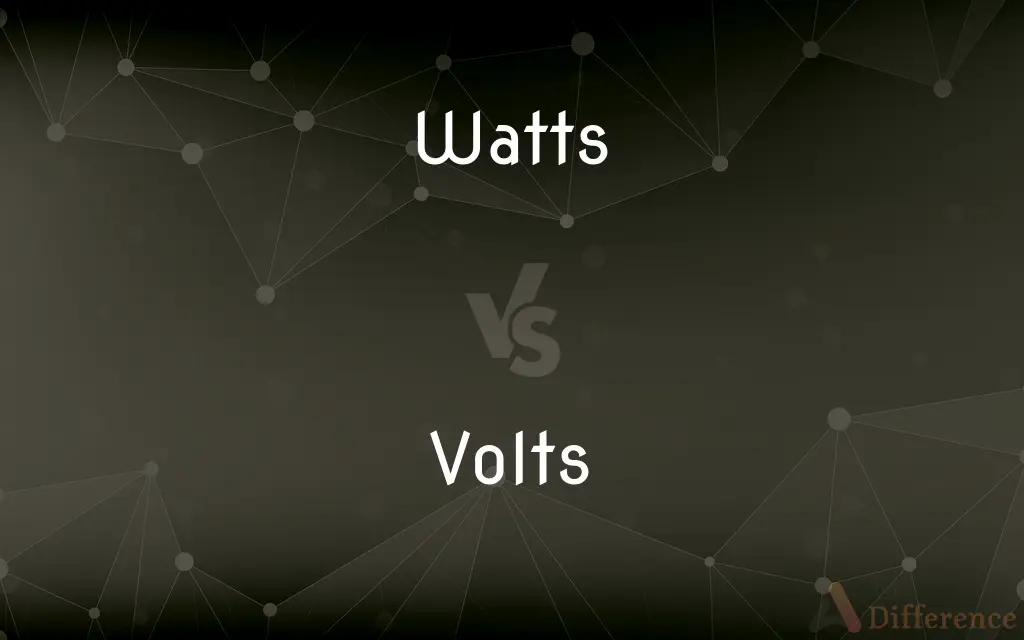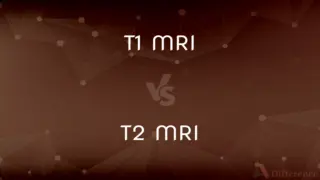Watts vs. Volts — What's the Difference?
Edited by Tayyaba Rehman — By Fiza Rafique — Published on November 1, 2023
Watts measure power or energy consumption, while Volts measure electrical potential or force.

Difference Between Watts and Volts
Table of Contents
ADVERTISEMENT
Key Differences
Watts and Volts are fundamental units in the realm of electricity and electronics, but they serve to quantify different aspects. A Watt, named after the engineer James Watt, is a measure of power. It indicates the rate at which energy is consumed or produced. In simpler terms, when you look at an appliance's wattage, you're seeing how much power it uses when it's operating. Volts, named after Alessandro Volta, gauge the electrical potential difference between two points. It can be thought of as the "pressure" pushing electrons through a conductor, and it signifies the force or "push" behind the current of electricity.
Considering Watts and Volts in a real-world context might offer clearer understanding. Imagine water flowing through a pipe. If Volts were the water pressure pushing the flow, then Watts would represent the actual flow rate or how much water is moving. Both units are interrelated, especially when considering Ohm's Law and the formula P = V^2/R, where P is power in Watts, V is voltage in Volts, and R is resistance.
It's also worth noting that while Volts represent potential, it doesn't mean anything without current (Amperes). The combination of Volts and Amperes gives us Watts. For instance, a 60-watt bulb powered by 120 volts consumes 0.5 amperes of current.
In summary, while both Watts and Volts are integral to understanding electrical devices and systems, they describe different properties. Watts look at energy consumption or production rate, while Volts focus on the force or potential difference pushing the electrical current.
Comparison Chart
Definition
Measures power or energy consumption
Measures electrical potential difference
ADVERTISEMENT
Unit Representation
W
V
Associated With
Power consumption
Electrical force
Derived From
Product of voltage (Volts) and current (Amperes)
Fundamental unit, not derived from other electrical units
Analogous To
Amount of water flowing through a pipe
Pressure pushing the water through a pipe
Compare with Definitions
Watts
Quantifies how quickly energy is used or produced.
This solar panel can produce up to 250 Watts in full sunlight.
Volts
Unit measuring electrical potential difference.
This battery supplies 9 Volts.
Watts
The product of voltage and current in an electrical circuit.
By increasing the voltage, the device's wattage also increased.
Volts
Quantifies the force behind electrical current.
The power outlet provides 120 Volts in most American homes.
Watts
A unit measuring power consumption.
This light bulb uses 60 Watts.
Volts
Denotes the potential energy per unit charge.
The electric fence emits a shock of 5,000 Volts.
Watts
Represents work done per unit of time.
My heater has a capacity of 1500 Watts.
Volts
Differential driving electric charge flow.
The motor requires a minimum of 12 Volts to operate.
Watts
The rate of energy transfer or conversion.
High-wattage appliances consume more electricity.
Volts
Represents the "pressure" in an electrical circuit.
Devices in Europe often run on 230 Volts.
Watts
Plural of watt
Volts
The SI-derived unit of electric potential and electromotive force, equal to the difference of electric potential between two points on a conducting wire carrying a constant current of one ampere when the power dissipated between the points is one watt. See Table at measurement.
Watts
English poet and theologian (1674-1748)
Volts
A circular movement executed by a horse in manège.
Volts
A sudden movement made in avoiding a thrust in fencing.
Volts
Plural of volt
Common Curiosities
How do Watts relate to electricity bills?
Electricity consumption is often billed in kilowatt-hours (kWh), where 1 kWh is the energy consumption of a device running at 1 kilowatt for one hour.
How is it defined?
One watt is equivalent to one joule of energy transferred or converted per second.
What is a Watt?
A Watt (W) is the unit of power in the International System of Units (SI) and measures the rate of energy transfer or conversion.
Are higher watts always better for appliances?
Not necessarily. While a higher wattage might mean a more powerful device, it also often means higher energy consumption.
Is wattage constant in electrical devices?
No, some devices like air conditioners may use more watts during startup and less while running.
What is it used for?
Watts measure the power consumption of devices or the power generation of sources like electric generators.
What's a megawatt?
A megawatt (MW) is one million watts and is often used to describe the output of large power plants.
Can high volts be dangerous?
Yes, high voltages can be hazardous as they can drive a large current through the body, leading to injury or death.
Can non-electrical things have wattage measurements?
Yes, any form of power, like mechanical power, can be measured in watts.
What is a Volt?
A Volt (V) is the SI unit of electric potential difference or electromotive force.
How is voltage measured?
Using a device called a voltmeter, which can measure the potential difference between two points in a circuit.
How do Watts relate to amperes and volts?
In electrical terms, power (Watts) equals current (amperes) multiplied by voltage (volts): P = I × V.
How does wattage affect the brightness of a light bulb?
Typically, higher wattage bulbs are brighter, but with modern LED technology, less power (watts) can produce the same brightness as older bulbs.
How do batteries indicate their strength?
Batteries often indicate their strength or "push" in volts, e.g., a 9V battery.
What happens if a device receives higher voltage than recommended?
Over-voltage can damage the device or reduce its lifespan.
How do volts differ from watts?
While volts measure electric potential difference, watts measure power or the rate of energy transfer.
What's a common household voltage?
It varies by country, with common standards being 110-120V or 220-240V.
How do transformers relate to voltage?
Transformers are used to increase (step-up) or decrease (step-down) voltages in electrical systems for various purposes, like transmission or device compatibility.
What does voltage mean in practical terms?
Voltage can be thought of as the "pressure" driving electric current through a circuit.
Is voltage constant in our homes?
While it's regulated, slight fluctuations can occur due to various factors, but they're usually within safe limits.
Share Your Discovery

Previous Comparison
Rankine Cycle vs. Brayton Cycle
Next Comparison
T1 MRI vs. T2 MRIAuthor Spotlight
Written by
Fiza RafiqueFiza Rafique is a skilled content writer at AskDifference.com, where she meticulously refines and enhances written pieces. Drawing from her vast editorial expertise, Fiza ensures clarity, accuracy, and precision in every article. Passionate about language, she continually seeks to elevate the quality of content for readers worldwide.
Edited by
Tayyaba RehmanTayyaba Rehman is a distinguished writer, currently serving as a primary contributor to askdifference.com. As a researcher in semantics and etymology, Tayyaba's passion for the complexity of languages and their distinctions has found a perfect home on the platform. Tayyaba delves into the intricacies of language, distinguishing between commonly confused words and phrases, thereby providing clarity for readers worldwide.












































